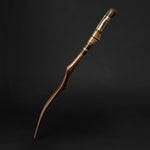You have no items in your shopping cart.
Recent Posts
-
Why an Elegant Cane Is a Thoughtful Gift for Loved Ones?
-
The Art of Christmas Design: Walking Canes That Celebrate the Season in Style
-
How an Ergonomic Walking Cane Handle Prevents Hand and Wrist Strain?
-
How to Walk With a Cane Correctly to Avoid Back or Shoulder Strain?
-
5 Common Mistakes People Make When Buying a Walking Cane (and How to Avoid Them)
-
How to Choose a Walking Cane That Reflects Your Personality (Not Just Your Needs)?
MOST POPULAR NOW
01
May
Canes were, for a period of at least three centuries, as crucial a part of the male wardrobe as a pair of trousers is now. Indeed, men were likely to have several canes, to be used on different occasions‚ at the office, going out in the evening and at the weekends.
They were carried, not as a walking aid, but as an ornament and an indication of the owner's wealth and status. Canes originated out of the male psyche, which associates carrying a stick with power. Kings carry sceptres, Black Rod carries a rod, Merlin carried a wand and Moses used a staff to part the waves. And in the 17th century, when men had just put down their swords, they started carrying canes
They continued to do so until the 1940s, when, sadly, they seemed to lay down their canes. But until then, some spectacular and unusual canes were produced, which now cost between £500 and £5,000. They could be classified into categories: for example, defence canes that contained hidden swords or blades; automaton canes that had heads that moved at the touch of a secret button; marine canes, made by sailors, frequently using whalebone; and folk art canes, carved and used by shepherds and farmers.
When canes first appeared, in about 1650, the most common was the ivory-handled malacca cane, the wood of which came from the Strait of Malacca in Malaysia. The wood was brought back to Britain as an exotic item, the equivalent now of buying something from the moon. The early canes had long brass ferrules to protect the wood against being dunked in the mud, while the handles were ivory with silver-pique work. These cost in the low thousands now.
By 1700, men and their canes were being dandified. The wood was the same, but the handles were often gold and decorated with tassels. Men would pose with them, rather than swing them around. Such canes can be found in Gainsborough portraits. Then came the Victorian age and the Industrial Revolution, in which the newly rich middle class would display their wealth through an extensive collection of highly decorative canes.
Cane factories opened all over Europe: in London, Paris and Vienna. The handles, meanwhile, became increasingly idiosyncratic. Many had animal heads, including mice, eagles and a variety of dog breeds. Increasingly exotic materials were used as decoration, such as jade or amber, and this continued until the Art Deco period, which produced some of the most spectacular canes of all.
A gentleman would have a number of canes - there would be a rustic cane, perhaps made of a stout wood such as ash, for walking the dogs and a more sober cane for the office. Then, for going to dinner and to the opera, a man would carry a lighter cane with a shaft made of an exotic wood, perhaps rosewood, with a gorgeous handle made out of something such as tortoise shell.
Whoever you were, there was a cane for you. If you were a Duke, there were canes that reflected your status in the richness of the wood. Peasants would carve their own canes and illustrate them with country pursuits, such as shooting, fishing and hunting. Sailors would use whalebone with whale teeth for the handles. Ebony and ivory, transported to Britain from the colonies, also ended up on canes. Some of these canes had additional functions. For example, defence canes could turn into a sword or a mace at the click of a button. There were also canes that could turn into umbrellas or could entertain. For example, automaton canes in the form of a duck‚head or a bulldog, cunningly designed so that the mouth could open to hold gloves while the owner was at the opera.
It is a great pity that canes are no longer seen on the street!
Also Purchased
-
Beige Walking Cane for Ladies Chamomile Flower, Wooden Walking Stick
Introducing our beautiful Beige Walking Cane for Ladies with Chamomile Flower, a Wooden Walking Stick that is hand carved and handmade, making it both pretty and unique. This walking cane...$79.50 -
Exotic Burl Wood Walking Cane – Fashionable Artisan Stick
A sculptural statement in deep, oceanic blue — this walking cane is more than a support accessory, it's wearable art. Meticulously hand-shaped from stabilized burl wood, the handle evokes the...$425.00 -
ArtWalkingSticks™ MAGIC Walking Cane, Handmade - Make to Order
This piece of art is created for those who value details. We make one of a kind, handcrafted wood and resin canes. Our Wooden Canes are completely unmatched in creativity....$430.00 -
Umbrella with Eagle Handle, Fashion Umbrella For Men
Make a bold and fashionable statement with our Umbrella with Eagle Handle - a unique and functional accessory designed for men. The striking eagle handle is the highlight of this...$325.00 -
Fashionable Lion Shoehorn Long Handle, Pearly Brown Shaft, Handmade
Introducing our Fashionable Lion Shoehorn, a handcrafted, long-handled shoe horn with a pearly brown shaft that's both stylish and practical. The intricate Lion design adds a touch of elegance to...$240.00 -
ArtWalkingSticks™ MAGIC Red Walking Cane - Unisex, Handmade
This piece of art is created for those who value details. We make one of a kind, handcrafted wood and resin canes. Our Wooden Canes are completely unmatched in creativity....$425.00
































